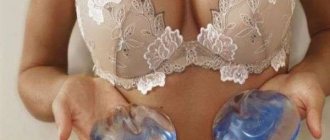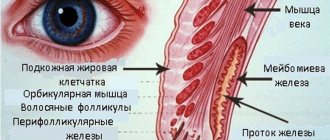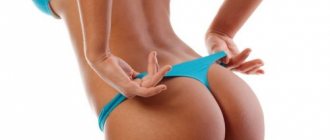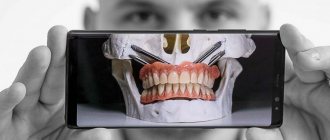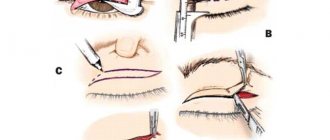- Preoperative period
- Preparing for surgery
- Choice of anesthesia
- Carrying out the operation
- Video of the operation
- Recovery period
- Contraindications
- Possible complications
Otoplasty is the surgical elimination of congenital or acquired (traumatic) ear defects. This operation is one of the most common in plastic surgery and allows you to adjust the size of the ears, their shape and location relative to the face. The surgical intervention affects the cartilaginous as well as soft tissues of the ears. Otoplasty is often recommended for children and adolescents, since protruding ears, asymmetry of the ears and other congenital defects can cause psychological disorders.
Preoperative period
In addition to choosing a clinic with an impeccable reputation and qualified staff, an important part of the preoperative period is a detailed consultation with the surgeon who will perform the intervention.
Modeling the shape of the ear
!Before otoplasty surgery, it is important that the patient and the doctor reach full understanding regarding the aspects of the proposed correction and its final result. The doctor explains to the patient how otoplasty is performed, how long the procedure itself and the rehabilitation period take, and what effect should be expected.
Modern high-level clinics have the ability to simulate the result of an operation on a computer in a digital 3D format. However, the client needs to understand that otoplasty surgery, like any other plastic surgery operation, is associated with certain risks. Realistic expectations about the final result include the possibility of insufficient correction or the development of some complications.
Preparing for surgery
Before undergoing plastic surgery, you must undergo a full medical examination. Direct preparation includes consultation with a therapist; if the patient has chronic diseases, a conversation with relevant specialists is also necessary. In addition, it is necessary to undergo a laboratory examination, as well as fluorography and electrocardiography.
Mandatory tests for otoplasty include:
- General blood analysis;
- Analysis of urine;
- Biochemical blood test (glucose, protein, electrolytes, urea, bilirubin);
- Testing for antigens and antibodies (tests for hepatitis and HIV);
- Test for syphilis.
Doctors need to find out whether the patient is prone to allergic reactions or the formation of keloid scars, and what operations they have undergone previously.
Before otoplasty it is necessary to undergo fluorography
Several weeks before the scheduled day of surgery, it is advisable to prepare the body. It is useful to take vitamins and follow a diet with sufficient amounts of protein, fruits and vegetables. Two weeks before surgery, the patient must stop taking medications that affect blood clotting. Smokers are advised to give up cigarettes at least temporarily. Moderation in alcohol consumption before and after surgery is also recommended.
On the appointed day, 4 hours before the procedure, it is advisable to refrain from drinking and eating. The day before surgery, you should thoroughly wash your hair and ears.
Before otoplasty, the surgeon also takes general and detailed photographs of the auricles, takes all necessary measurements of each ear, determines the relationship of the ears to the border of the scalp, takes into account the presence of asymmetry and the relative position of the concha, lobe, and helix.
What does a bandage look like and what is it?
There are several different types of bandages. This is again due to the scale of the operation.
There are 2 types of dressings:
- compression
- resembles the most ordinary headband with Velcro, 7 cm wide, but made of a special material impregnated with antiseptic solutions. This fabric prevents infection from entering wounds. The material is elastic, does not exert excessive pressure, but at the same time securely fixes the ears and protects from mechanical damage. The advantage of this product is head mobility. In addition, the material allows air to pass through, so it is not hot even at high temperatures; - mask
– covers the chin and neck. A special material is used, hypoallergenic, with a deodorizing effect. The mask blocks sudden movements of the head, which prevents possible injuries during sleep. The downside of the product is that it is hot in it, since the mask covers a fairly large area.
The doctor will indicate which form is required after surgery.
It is recommended to purchase 2 pieces at once in order to change them regularly. The fact is that when removing the bandage, it is necessary to lubricate the seams with Vaseline each time to prevent moisture and infection from entering, and this does not have the best effect on the fabric.
It is very important to choose the correct size of the product. The bandage should not put too much pressure on the head, much less the ears. There are different types of headbands for children and adults; they come in different sizes, so choosing the best option is always possible.
You can purchase the product at almost any pharmacy. Its cost varies from 1000 to 1500 rubles.
In extreme cases, the bandage can be replaced with an elastic bandage. However, this is really an extreme case, since this kind of fixation has a number of disadvantages:
- The special bandage contains Velcro, which allows you to adjust the degree of pressure without removing it. If the elastic bandage tightens too much or, conversely, does not create the proper pressure, it will have to be completely rewound, that is, the stable position of the auricle will already be disrupted;
- the elastic bandage does not allow for the passage of air, so it is very hot in such a bandage;
- It is quite difficult to guess the degree of pressure, so applying a bandage requires certain skills. In addition, ready-made head models are much more aesthetically pleasing.
A tennis bandage is a more acceptable option, but only as a bandage, and not a post-operative option, since such material is not treated with antiseptics and does not protect against infection.
Choice of anesthesia
The choice of type of anesthesia for otoplasty depends on many factors:
- Patient's age;
- Difficulties of the operation;
- Estimated duration of the surgical procedure;
- Presence of concomitant diseases;
- Psychological state of the patient.
In children and adolescents, the intervention is performed under general anesthesia (drugs are administered intravenously). In healthy adult patients, surgery is often performed under local anesthesia. Sometimes sedative and analgesic medications are administered intravenously.
Carrying out the operation
Otoplasty cannot be classified as a difficult operation for a qualified specialist: it is performed on an outpatient basis (the patient does not need to be hospitalized).
Prominent ears can be corrected with otoplasty
If correction of protruding ears in children is carried out, then the ideal time for otoplasty is 5-8 years. By this time, the child has not yet had time to form a critical attitude towards his appearance, and in the future, young patients simply forget that they were once “lop-eared.”
Otoplasty options depend on the anatomical features and the technique chosen by the surgeon based on his professional experience. ! Modern aesthetic surgery includes more than 150 methods for correcting protruding ears and other ear defects. The general goal of protruding ear surgery is to bring the ears closer to the head: this is achieved by plastic surgery of the cartilage that forms the basis of the outer ear.
For these purposes, an area of skin behind the ear is excised, and the cartilage is partially removed (or it is shaped in such a way as to give the shell the most aesthetic appearance). This way, the incisions and future scars remain on the back of the ear, making them invisible. Over time, the scars become completely invisible.
Bandage after otoplasty surgery
The ideal angle between the concha of the ear and the head is 30°, while the distance between the head and the edge of the ear should not exceed 2 cm. The deformation can be observed in both ears or one, and the types and degrees of protruding ears and other ear defects are so diverse that there is no single medical tactic there is simply no fix.
! The duration of the operation depends, of course, on its complexity and course. Usually the procedure takes from half an hour to 2 hours. The patient remains in the clinic for several hours (sometimes until the next morning). The next day he can do his normal activities. Children can start school in a week.
Immediately after the treatment, medical napkins and a special bandage after otoplasty are applied to the correction areas. A special tampon soaked in plant oils and antiseptic components is inserted into the ear canal. The tampon should be changed every three days. A day after surgery, the first dressing is performed. A photo of the postoperative period of otoplasty clearly demonstrates the condition of the patient’s ears after the procedure.
How long to wear a bandage after otoplasty
There are about 170 ear correction techniques. However, any of them involves fixation of the operated area. A special bandage is designed to prevent possible deviations in.
Wearing the product is necessary to perform the following tasks:
- After otoplasty, cotton swabs soaked in special oil are placed in the ears. This is a necessary stage of rehabilitation. The bandage holds the material securely;
- It is very important to maintain the new shape of the auricle, and for this you need to prevent the slightest shaking of the tissues. This is the main purpose of a compression bandage;
- moderate pressure helps relieve postoperative pain;
- the device prevents the inflammatory process. After otoplasty, for some time the ear turns into a “weak link” and needs to be additionally protected;
- in the same way, the bandage prevents the occurrence and development of infections;
- preventing bruising is also one of the purposes of the bandage.
To complete all tasks, it is very important to choose the right product. Both excessive pressure and insufficient pressure will be equally detrimental to the result of the operation.
The duration of wearing the bandage depends on the extent of the intervention and the speed of recovery. If you ignore this requirement, the following are quite possible:
- ear asymmetry;
- on the operated area;
- slow healing due to swelling and risk of bleeding;
- inflammation and;
- and scars, which is associated with lack of fixation and tissue irritation.
Recovery period
Immediately after surgery, the doctor prescribes painkillers (analgesics), which should be taken again after 2-3 hours and before bedtime. Pain after otoplasty usually does not last longer than a day or may be quite mild for several days. To eliminate pain symptoms, pharmaceutical analgesic drugs are quite suitable. Hematomas can be severe for a week, after which they gradually disappear. Swelling after otoplasty persists for 1.5 months.
Suture line after otoplasty
For a week, you should definitely wear a bandage made of several layers, which fixes the ears in a certain position and provides protection from mechanical stress (see photo of the bandage after otoplasty). Patients should also protect their ears from water getting into them. Sutures after otoplasty are removed after about 7 days.
! Complete rehabilitation after otoplasty lasts approximately six months. For 5-8 weeks, the patient is recommended to sleep in a special fixing bandage that prevents the displacement of cartilage. The bandage is put on after the stitches are removed. You should also protect your ears after otoplasty from insolation (solar radiation) and exposure to cold wind.
You can wash your hair 2 weeks after surgery. You can't go to the sauna or swimming pool for a month and a half. After 3 and 6 months, the patient should visit the surgeon for examination and consultation regarding the course of the recovery period.
During the rehabilitation period after otoplasty, patients are not recommended to engage in contact sports, diving, or weightlifting, since there is a high probability of injury and deformation of the operated cartilage.
Reviews from patients after otoplasty surgery are mostly positive - after recovery, people quickly get used to their new appearance and get rid of all complexes and psychological problems associated with ear defects, if any.
General recommendations from doctors
During the rehabilitation period after plastic surgery on the ears, it is important to follow the recommendations of doctors at all stages. This will speed up wound healing and overall recovery after surgical repair. Such advice includes the following suggestions:
- It is necessary to use ointment to accelerate tissue regeneration with each dressing, applying it to the scar (Levomekol).
- Do not use any detergents to wash your hair, except shampoos for children.
- Use a bandage your ears from mechanical injury and from exposure to direct sunlight.
- Eat foods rich in proteins and vitamins, do not smoke or drink alcohol.
- If there is no bandage, wear a mesh stocking specially made to secure the headband.
- To avoid swelling, you need to sleep with elevated .
Possible complications
Otoplasty, rehabilitation after which requires a serious approach, can also cause complications. Negative consequences are rare and almost always occur as a result of patients’ non-compliance with medical recommendations. Complications after otoplasty due to medical error are also possible.
Ear swelling is one of the complications
Complications after ear correction include:
- The occurrence of allergies (epidermal blisters) - this may be a reaction to anesthetics and other medications;
- Complications due to anesthesia (more often occur in children);
- Inflammation of soft tissues (prolonged swelling and redness of the ears);
- Inflammation of cartilage tissue (perichondritis);
- Formation of keloid scars;
- Deterioration of the aesthetic result due to spontaneous deformation of the ears.
Some of these complications can be prevented if you strictly follow your doctor's instructions. If negative reactions develop, repeated correction of the ears may be required, which can be carried out no earlier than 6 months after the first procedure.
If the patient follows all the recommendations for the rehabilitation period after otoplasty, no re-correction will be required. The result will be sustainable and will remain with the person for life.
Stages of rehabilitation
Typically, after otoplasty is performed, recovery begins within a couple of hours. Immediately after the operation, the ears are fixed with a special plaster, a cotton compress with a healing agent is applied to them, and a tight elastic bandage around the head maintains the correct position. The entire rhinoplasty rehabilitation period is divided into several key stages.
It is advisable to avoid playing ball, contact martial arts and other sports in which the ears can be injured.
